Latitude: 57 32.836N
Longitude: 169 15.240W
Most of the scientists and crew aboard the Healy are admittedly much saltier and more sea-savvy than I. In random moments of desperate seasick agony many have even offered thoughtful, comforting words such as "This is nothing?!" or "I've heard that it is going to get waaay worse!". The storm that we were caught in during this weekend, however, was powerful enough to put everyone's plans through the spin cycle. We traveled in circles trying to decide what to do. Everyone was waiting to see how bad the storm would be before deciding in which direction to head. This is what it looked like from the bow...
http://
The plan to launch a small boat off the starboard side of the ship to collect sediment traps from the ocean floor quickly went from being categorized as "tricky" to "not an option" on Friday as the winds gusted upwards of 50 knots. So if the small boat was out of the question, the new question was how to get the traps back on the boat? Steering a large vessel like the Healy to such a precise spot as four buoys and a tracking beacon is no small feat. Then, there was the issue of what to do if we got into that position. The science team and the Coast Guard put their heads together to find a solution.
Lowered to 100m below the surface, this series of clear tubes was sent down with the goal of catching sediment as it falls out of the water column. By catching "sediment" or material as it falls from the surface, scientists Pat Kelly, Mike Lomas and Doug Bell, hope to understand how nutrients and carbon are moving around the Bering Sea ecosystem in a very specific way. They will be examining the sampled matter as not only food for benthic organisms such as crabs and clams but also for its role in global carbon cycling. PhytoplanktonSmall or microscopic aquatic plants that float or drift in fresh or salt water. floating at the surface may remove CO2 from the atmosphere. As they die and sink to the bottom, some of this carbon dioxide goes with them. The rate at which it is taken out of the atmosphere and how much exists in the murky depths is especially interesting in terms of global warming.
Hence, the sediment traps. By placing tubes at 25, 40, 50, 60 and 100m, the scientists can look at how the particle content changes with depth. They look for the presence of markers such as Thorium and other "sticky" elements that like to hang onto organic matter as a tracer for the movement of particles in water samples collected from CTDA research tool that is submerged in the water to measure conductivity (salinity), temperature, and depth. casts. Pairing what they find in this cast, with the information that they find from ice anchored and drifting sediment traps, the team can piece together a complete picture of falling sediment activity.
Pat Kelly of the University of Rhode Island, explains "The Bering Sea has historically been benthic in-fauna rich." (Lots of animals living at the bottom). "We are trying to find out if it is shifting from a benthic-oriented system to a more pelagic environment (animals that live and feed within the water column) and look at how climate change is affecting this environment."
The traps were set out for 24 hours so that an entire day's activity could be studied. If they were deployed any longer, preservatives would need to be put in to keep the organic decay and animal waste from skewing the results. Picking them up on time was a must.
Friday's winds were just too high to put the small boat in the water. Plan B had to be put into action. Using grapple hooks, harnesses and lots of rope the scientists and the marine science technicians (MSTs) worked along with the crew steering the boat. As the ship was brought alongside the buoys marking the trap location, everyone sprung into action. Ray-Mendoza, clipped a leader from the winch into the buoys. Pulling it alongside the boat, the hand-off began to bring it around to the fantail. Once at the very back of the boat, the team could work to pull the traps aboard, secure the equipment and get busy analyzing the samples. While the whole operation was pretty tricky, the equipment made it safely onto the deck and the crew stayed aboard. All in all a success!
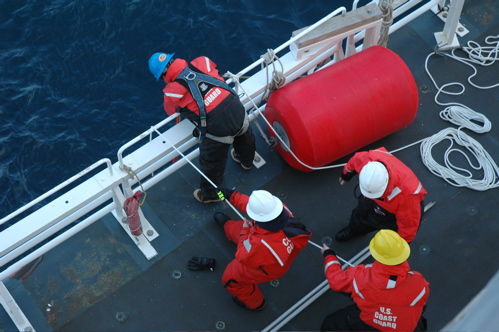
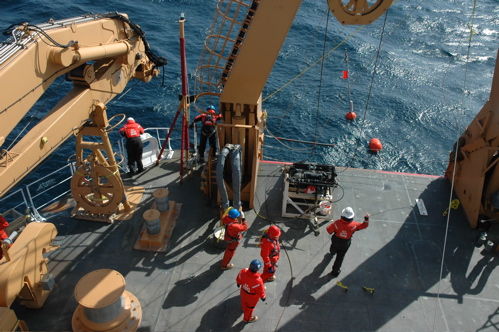
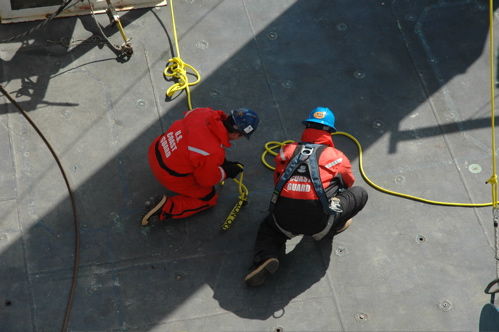
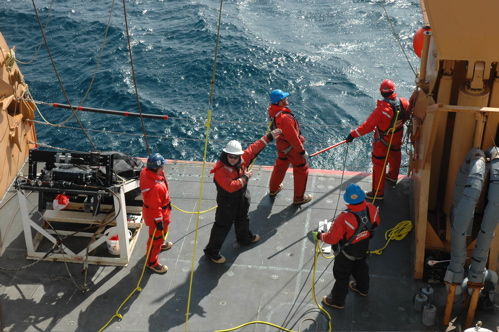
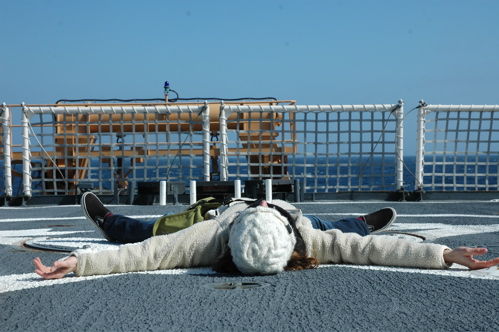


Comments